|
|
Discoveries


 This unique and historic $7 Continental Currency Note is accompanied by a handwritten envelope and letter documenting its pedigree back to 1776. It was just authenticated and certified by PCGS Banknote and is being offered for sale for the first time. The fascinating history surrounding this set follows the genealogy tree of the Taft Family dating back to 1640, which includes President William Taft. This $7 Continental Currency note was in the extended Taft Family since the American Revolution in 1776. This incredible discovery was unknown to the numismatic community until now. This unique and historic $7 Continental Currency Note is accompanied by a handwritten envelope and letter documenting its pedigree back to 1776. It was just authenticated and certified by PCGS Banknote and is being offered for sale for the first time. The fascinating history surrounding this set follows the genealogy tree of the Taft Family dating back to 1640, which includes President William Taft. This $7 Continental Currency note was in the extended Taft Family since the American Revolution in 1776. This incredible discovery was unknown to the numismatic community until now.
 The American Revolution was a movement for independence, including political, social, and ideological change. Between 1765 and 1775 the desire for independence grew, resulting in protests and boycotts including the Stamp Act and Boston Tea Party. The first battles at Lexington and Concord in April of 1775 started the Revolutionary War between the American colonies and Britain. The American Revolution was a movement for independence, including political, social, and ideological change. Between 1765 and 1775 the desire for independence grew, resulting in protests and boycotts including the Stamp Act and Boston Tea Party. The first battles at Lexington and Concord in April of 1775 started the Revolutionary War between the American colonies and Britain.
 The Second Continental Congress established the Continental Army which appointed George Washington as its commander-in-chief in June 1775. The $7 Continental Currency notes were issued during the American Revolution by the Continental Congress as part of their effort to finance the war against Great Britain. The Continental Congress lacked the ability to levy taxes or generate revenue through other means, so they printed paper money, known as Continental currency, in large quantities to fund the war effort and to pay soldiers. This $7 note was issued on February 17th, 1776. It was part of the second issue of currency by the Continental Congress. The Second Continental Congress established the Continental Army which appointed George Washington as its commander-in-chief in June 1775. The $7 Continental Currency notes were issued during the American Revolution by the Continental Congress as part of their effort to finance the war against Great Britain. The Continental Congress lacked the ability to levy taxes or generate revenue through other means, so they printed paper money, known as Continental currency, in large quantities to fund the war effort and to pay soldiers. This $7 note was issued on February 17th, 1776. It was part of the second issue of currency by the Continental Congress.
 Ultimately, the Continental Currency became largely useless after the war, contributing to the financial instability of the early United States. The experience of hyperinflation caused by the Continental Currency was one of the factors that led to the adoption of the U.S. Constitution, which gave the federal government the power to coin money and regulate its value. Ultimately, the Continental Currency became largely useless after the war, contributing to the financial instability of the early United States. The experience of hyperinflation caused by the Continental Currency was one of the factors that led to the adoption of the U.S. Constitution, which gave the federal government the power to coin money and regulate its value.
 On July 4th 1776, the Declaration of Independence was signed. But major battles between the British and American colonies continued until 1781, with the American victory over the British at Yorktown. The War ends officially with the Treaty of Paris, signed in 1783. On March 4, 1789 the new United States Government, which was created by the Constitution officially began operations, replacing the old Articles of Confederation. On July 4th 1776, the Declaration of Independence was signed. But major battles between the British and American colonies continued until 1781, with the American victory over the British at Yorktown. The War ends officially with the Treaty of Paris, signed in 1783. On March 4, 1789 the new United States Government, which was created by the Constitution officially began operations, replacing the old Articles of Confederation.
 This $7 note was given to sergeant Frederick Taft for his service in the Revolutionary War and stayed in the Taft Family from 1776 until 2025. The letter and envelope written in 1843, document the pedigree of this $7 note. This $7 note was given to sergeant Frederick Taft for his service in the Revolutionary War and stayed in the Taft Family from 1776 until 2025. The letter and envelope written in 1843, document the pedigree of this $7 note.
 The Taft family came from England, Scotland, Ireland and France. The first known ancestor of the Taft family in the United States, Robert Taft Sr., was born in 1640. He began a homestead in Mendon, Massachusetts (circa 1680). Today it is known as Uxbridge, Massachusetts, where he passed away in 1726. The Taft family came from England, Scotland, Ireland and France. The first known ancestor of the Taft family in the United States, Robert Taft Sr., was born in 1640. He began a homestead in Mendon, Massachusetts (circa 1680). Today it is known as Uxbridge, Massachusetts, where he passed away in 1726.
 Descendants of the Taft family lived for five generations on farms in Massachusetts before branching out to New York, Maryland and Ohio. Prominent family members include a Governor of Rhode Island, a United States Senator from Ohio, and a U.S. Secretary of Agriculture. The most famous Taft Family member was William Howard Taft, who became the 27th President of the United States. Descendants of the Taft family lived for five generations on farms in Massachusetts before branching out to New York, Maryland and Ohio. Prominent family members include a Governor of Rhode Island, a United States Senator from Ohio, and a U.S. Secretary of Agriculture. The most famous Taft Family member was William Howard Taft, who became the 27th President of the United States.
 The Taft family was very prominently represented as soldiers in the Revolutionary War, mostly in the New England states. Following the Taft genealogy three generations later, Samuel Taft (1735-1816) served in the Continental Army and was the proprietor of a tavern in Uxbridge, now known as Samuel Taft House. President George Washington visited Samuel Taft in 1789 on his inaugural tour of New England. Samuel Taft was the father of Frederick Taft, who was the sergeant in the American Revolution, and the original link to the pedigree of this $7 1776 note. The Taft family was very prominently represented as soldiers in the Revolutionary War, mostly in the New England states. Following the Taft genealogy three generations later, Samuel Taft (1735-1816) served in the Continental Army and was the proprietor of a tavern in Uxbridge, now known as Samuel Taft House. President George Washington visited Samuel Taft in 1789 on his inaugural tour of New England. Samuel Taft was the father of Frederick Taft, who was the sergeant in the American Revolution, and the original link to the pedigree of this $7 1776 note.
 Frederick Taft was born on June 19th, 1759. He served in the Revolutionary War as a sergeant in one of the local militia units. Like many small towns in New England, Uxbridge contributed resources, including supplies, food, and ammunition, to the war effort. This was vital in the early stages of the war, when resources were limited, and each town had to do its part to support the Continental Army. He married Abigail Wood in June of 1782. Frederick and Abigail were the parents of Parla Parilla "Parly" Taft, who was born on March 5, 1798. She married Amory Warren on May 17, 1821. Frederick Taft was born on June 19th, 1759. He served in the Revolutionary War as a sergeant in one of the local militia units. Like many small towns in New England, Uxbridge contributed resources, including supplies, food, and ammunition, to the war effort. This was vital in the early stages of the war, when resources were limited, and each town had to do its part to support the Continental Army. He married Abigail Wood in June of 1782. Frederick and Abigail were the parents of Parla Parilla "Parly" Taft, who was born on March 5, 1798. She married Amory Warren on May 17, 1821.
 One of their sons was Dr. Royal Sibley Warren (1822-1896), who was the 4th-great-grandson of Robert Taft, Sr. He was born on September 12, 1822, in Alstead, New Hampshire. He was the eldest of seven children. Dr. R.S. Warren was one of the many pioneers and prominent men of Middlesex County, Massachusetts, in the 1800s. A physician and a microscopist, he earned his medical degree from Harvard Medical College in 1846. Then he settled in Waltham, Massachusetts in 1847 and started a large medical practice that lasted until 1881. One of their sons was Dr. Royal Sibley Warren (1822-1896), who was the 4th-great-grandson of Robert Taft, Sr. He was born on September 12, 1822, in Alstead, New Hampshire. He was the eldest of seven children. Dr. R.S. Warren was one of the many pioneers and prominent men of Middlesex County, Massachusetts, in the 1800s. A physician and a microscopist, he earned his medical degree from Harvard Medical College in 1846. Then he settled in Waltham, Massachusetts in 1847 and started a large medical practice that lasted until 1881.
 He married Susan E. Bates on July 10, 1850 and had six children. Eventually he built a house in Waltham between 1851 and 1853. However, in 1865 he had a terrible railroad accident that made him permanently disabled and homebound for almost a year. Despite his disability, he joined politics and was elected on November 5, 1867 to represent Waltham in the Legislature, becoming one of the 240 members of the 1868 Massachusetts House of Representatives, serving until June 24, 1869. Additionally, he also served on the School Committee and was responsible for the oversight and management of goals and policies of their local public school system. He married Susan E. Bates on July 10, 1850 and had six children. Eventually he built a house in Waltham between 1851 and 1853. However, in 1865 he had a terrible railroad accident that made him permanently disabled and homebound for almost a year. Despite his disability, he joined politics and was elected on November 5, 1867 to represent Waltham in the Legislature, becoming one of the 240 members of the 1868 Massachusetts House of Representatives, serving until June 24, 1869. Additionally, he also served on the School Committee and was responsible for the oversight and management of goals and policies of their local public school system.
 R.S. Warren retired to Colorado Springs, Colorado, in 1881, with his wife and two daughters. He passed away on February 13, 1896 and was later buried in Evergreen Cemetery, Colorado Springs, Colorado on May 15, 1896. After his death, his wife, children, and their families settled in Massachusetts, Colorado, and California. His house in Waltham, subsequently became part of Massachusetts' historic buildings. R.S. Warren retired to Colorado Springs, Colorado, in 1881, with his wife and two daughters. He passed away on February 13, 1896 and was later buried in Evergreen Cemetery, Colorado Springs, Colorado on May 15, 1896. After his death, his wife, children, and their families settled in Massachusetts, Colorado, and California. His house in Waltham, subsequently became part of Massachusetts' historic buildings.
 In 1843, R.S. Warren wrote a letter documenting that the $7 Continental Currency Note from 1776 was given to him by his grandfather, Frederick Taft. In this letter, he also mentioned that Frederick Taft was a soldier in the American Revolution and received this note as payment for his service. In 1843, R.S. Warren wrote a letter documenting that the $7 Continental Currency Note from 1776 was given to him by his grandfather, Frederick Taft. In this letter, he also mentioned that Frederick Taft was a soldier in the American Revolution and received this note as payment for his service.
 The Taft family expanded westward over the generations, with one branch of the Taft family settling in Ohio. Alphonso Taft (1810-1891) became a prominent figure in state and national politics. He attended Yale University, where he founded the Skull and Bones society. He later was Secretary of War and Attorney General of the United States. Alphonso's son, William Howard Taft, was born on September 15th, 1857. The Taft family expanded westward over the generations, with one branch of the Taft family settling in Ohio. Alphonso Taft (1810-1891) became a prominent figure in state and national politics. He attended Yale University, where he founded the Skull and Bones society. He later was Secretary of War and Attorney General of the United States. Alphonso's son, William Howard Taft, was born on September 15th, 1857.
 William Howard Taft was the 4th-great-grandson of Robert Taft Sr. He was also a distant cousin to both Frederick Taft and R.S. Warren (Frederick Taft's grandson). He served as the 27th President of the United States from 1909 to 1913 and the tenth Chief Justice of the United States Supreme Court from 1921 to 1930. William Howard Taft was the 4th-great-grandson of Robert Taft Sr. He was also a distant cousin to both Frederick Taft and R.S. Warren (Frederick Taft's grandson). He served as the 27th President of the United States from 1909 to 1913 and the tenth Chief Justice of the United States Supreme Court from 1921 to 1930.
 The connection of President William Howard Taft to Robert Taft Sr. is documented through genealogical records that span from colonial Massachusetts to the Presidency of the United States. The connection of President William Howard Taft to Robert Taft Sr. is documented through genealogical records that span from colonial Massachusetts to the Presidency of the United States.
 This $7 Continental Currency Note, along with the handwritten envelope and letter, was kept by relatives of R.S. Warren and finally sold to a coin dealer in 2025 who submitted this set to PCGS Banknote. This $7 Continental Currency Note, along with the handwritten envelope and letter, was kept by relatives of R.S. Warren and finally sold to a coin dealer in 2025 who submitted this set to PCGS Banknote.
 It is amazing that this $7 Continental Currency Note survived in the extended Taft family for 250 years. This unique numismatic discovery belongs in a museum, a collection of U.S. Currency, a collection of American Revolution antiques, or in a collection containing rare items from our nation's history. It is amazing that this $7 Continental Currency Note survived in the extended Taft family for 250 years. This unique numismatic discovery belongs in a museum, a collection of U.S. Currency, a collection of American Revolution antiques, or in a collection containing rare items from our nation's history.
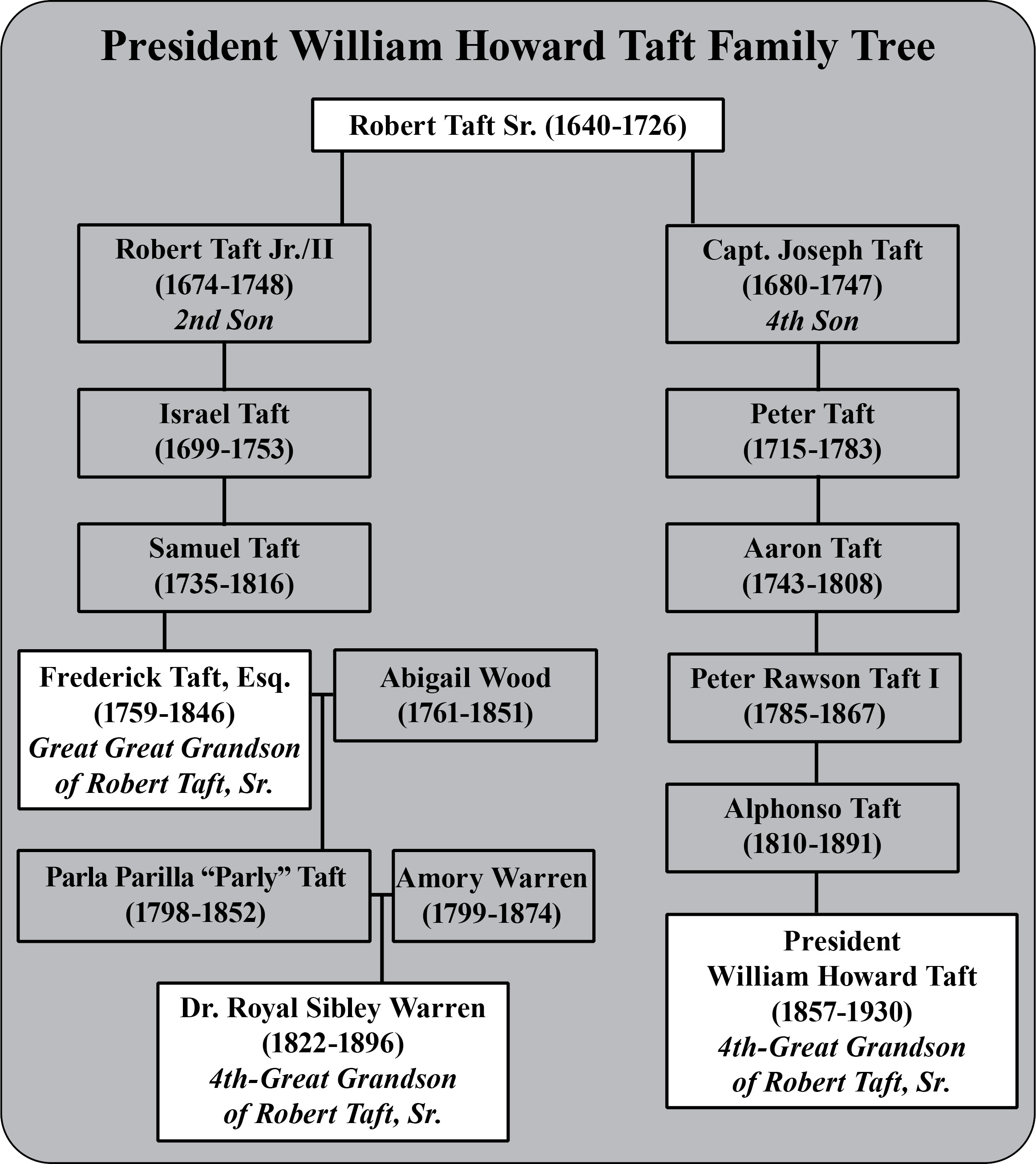
1 of 3: American Revolution / Continental Currency
Fr. CC-29 Feb. 17, 1776 $7
Serial # 197521 Printer: Hall & Sellers, PA
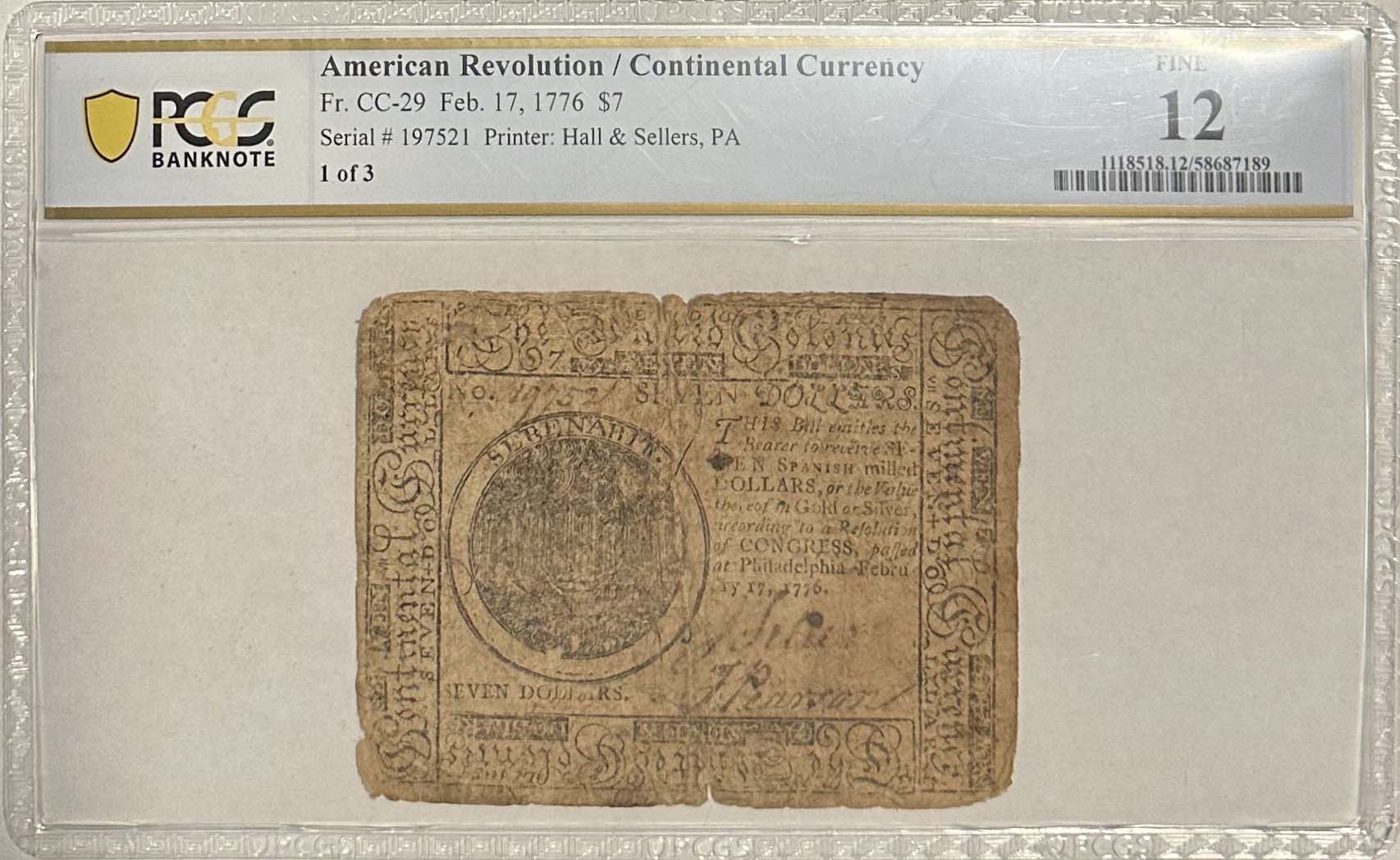
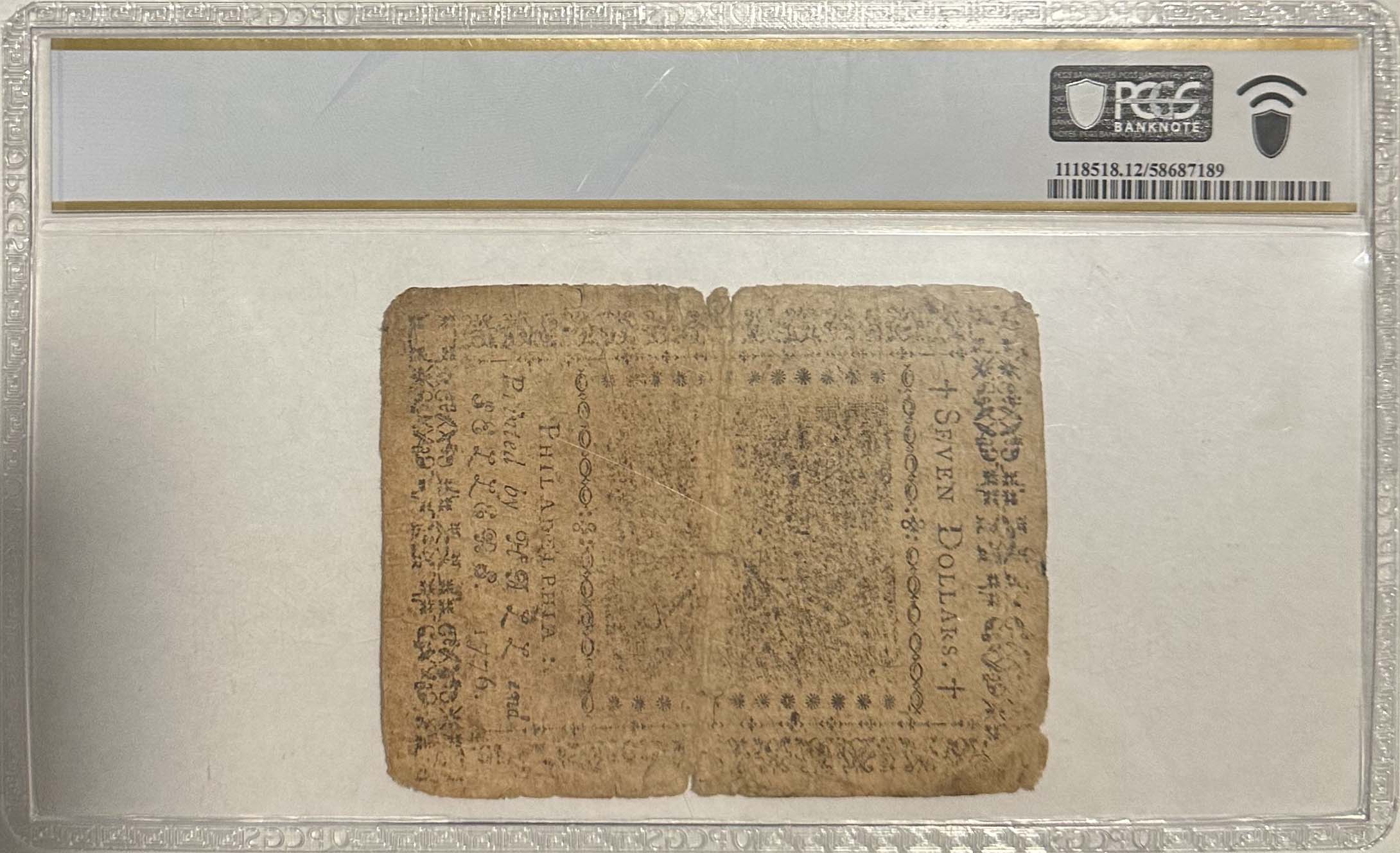
PCGS Banknote Certification Number 58687189:

2 of 3: (1843) Envelope - Uxbridge, Massachusetts
(PCGS typos: envelope is from 1843, not 1834 and
lines 2 & 3 are switched, $7 Note is from Frederic Taft)
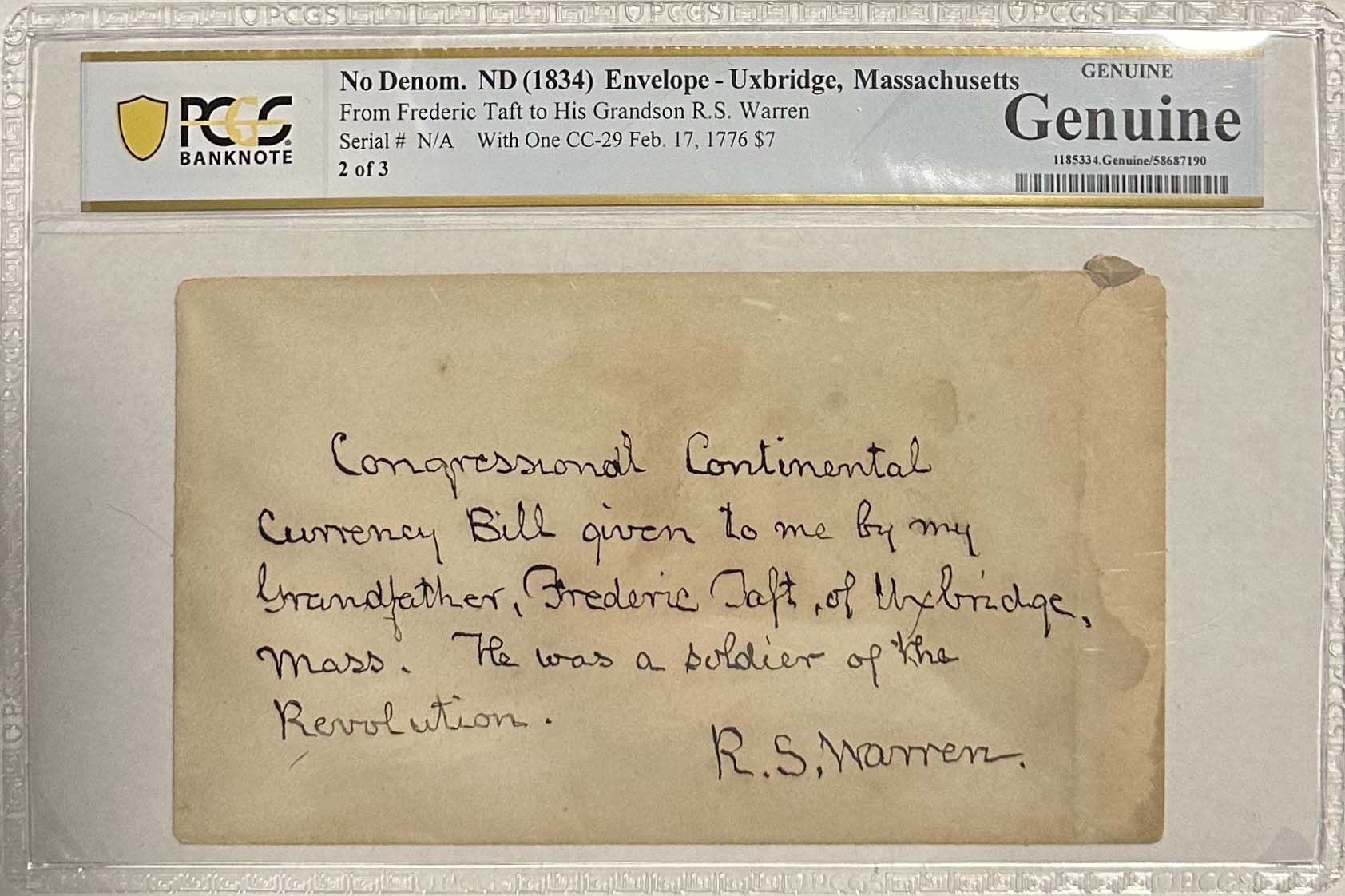
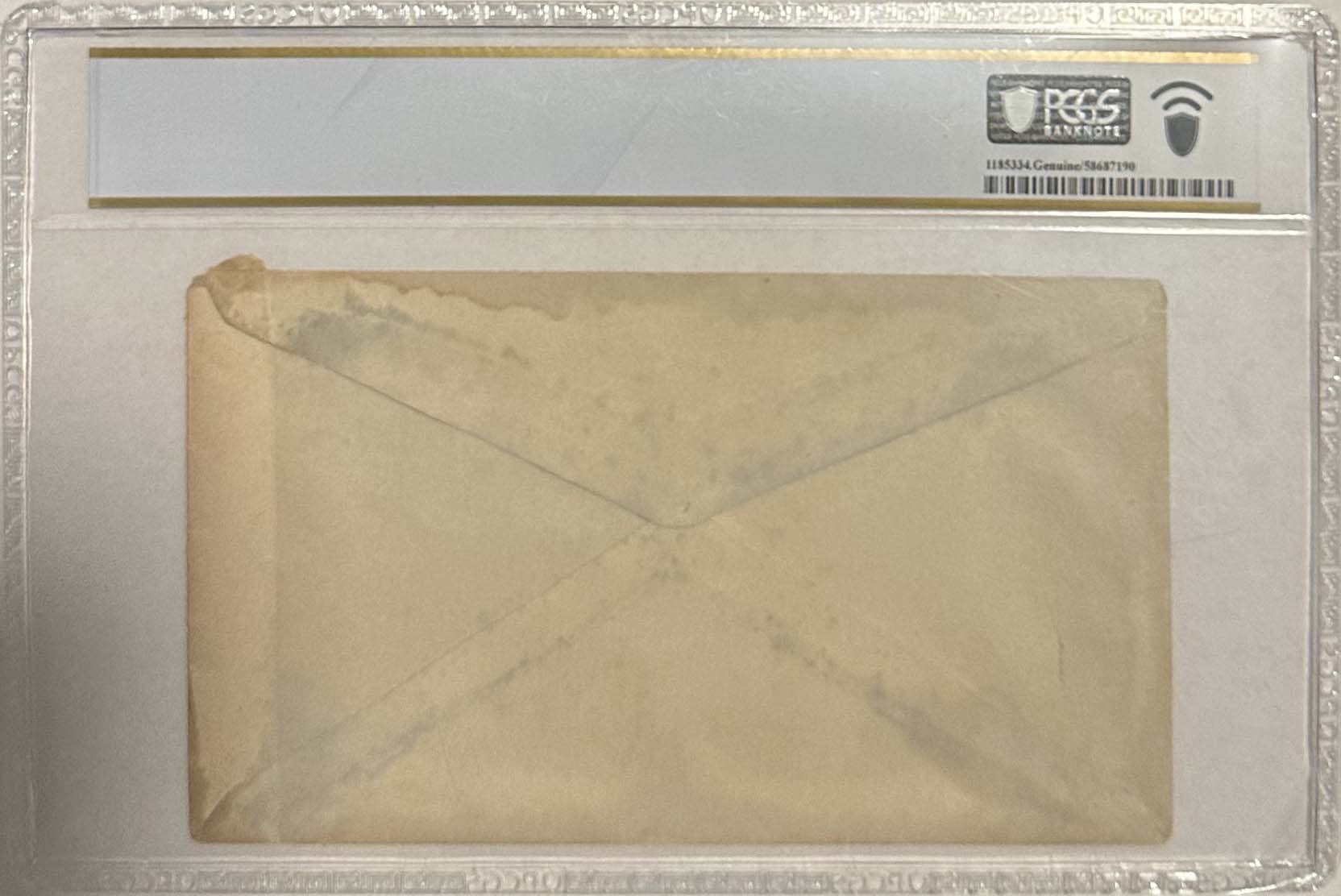
The envelope reads:
Congressional Continental Currency Bill given to me by my Grandfather, Frederic Taft, of Uxbridge, Mass. He was a soldier of the Revolution.
R.S. Warren.
PCGS Banknote Certification Number 58687190:

3 of 3: 1843 Letter - Uxbridge, Massachusetts
(PCGS typos: letter is from 1843, not 1834 and
lines 2 & 3 are switched, $7 Note is from Frederic Taft)
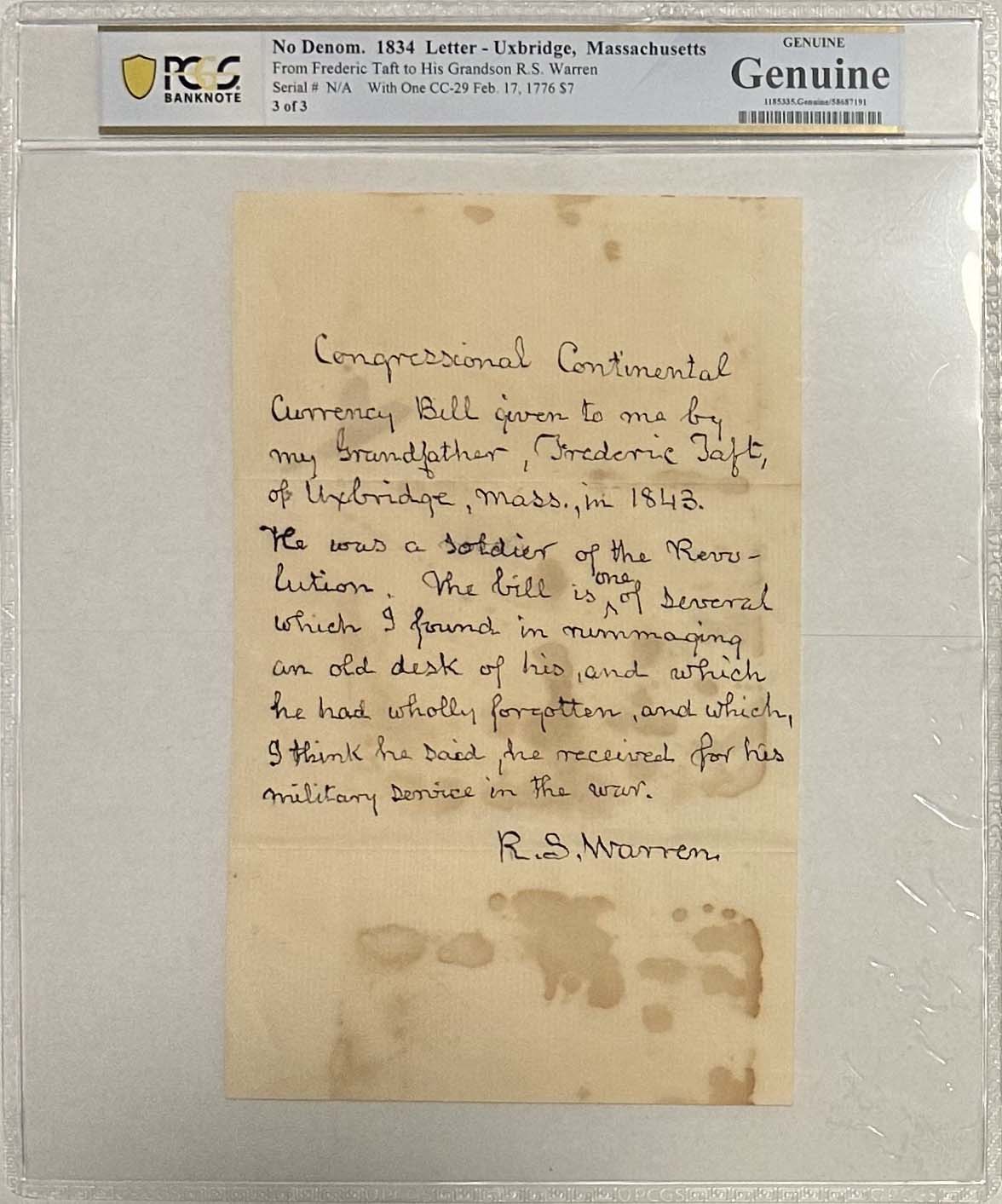
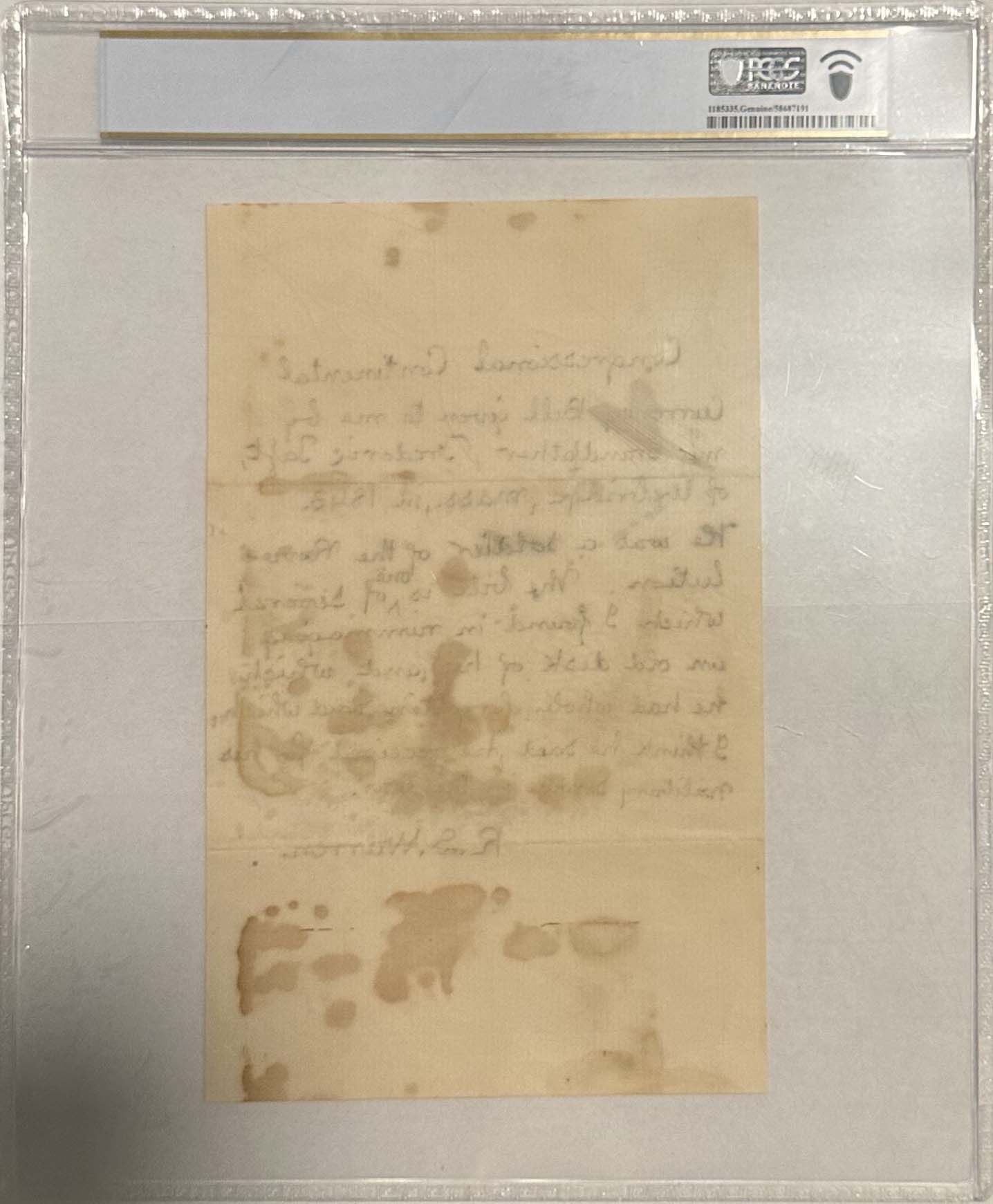
The letter reads:
Congressional Continental Currency Bill given to me by my Grandfather, Frederic Taft, of Uxbridge, Mass., in 1843. He was a soldier of the Revolution. The bill is one of several which I found in rummaging an old desk of his, and which he had wholly forgotten, and which, I think he said he received for his military service in the war.
R.S. Warren.
PCGS Banknote Certification Number 58687191:

Featured on the cover of the upcoming
Mint Error News Magazine Issue 84:
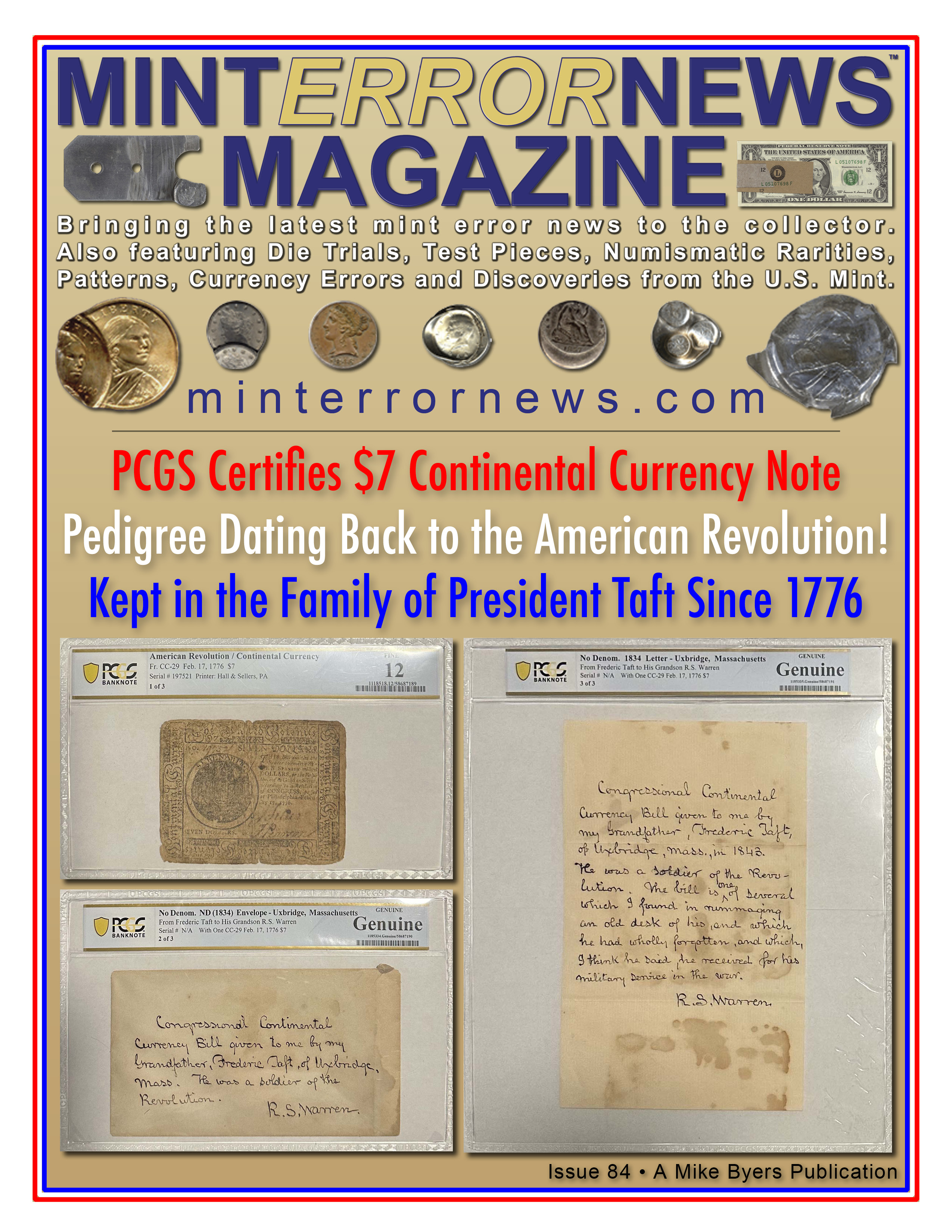
About The Authors:
Mike Byers
Publisher & Editor
minterrornews.com
Mike Byers is the Publisher and Editor of Mint Error News, author of the NLG award winning book World's Greatest Mint Errors. He is the largest dealer of the world's rarest mint errors and can be reached at mikebyers.com.
Greg Bennick
Mint Error News Consultant, CONECA Board Member and TAMS Board Member. Greg assisted with the genealogical research for this article.
Marc Crane
Mint Error News Consultant for Mint Errors, Patterns & Die Trials. He started Marc One Numismatics, Inc. in 1991. He is a member of the PNG (#565). Marc assisted with the historical documentation for this article.


|
|
|